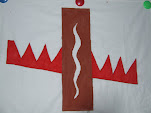Eso’s Chronicles 329 / 5
Odds and Ends
© Eso A.B.
All comments appearing within brackets [ ] are editorial in origin.
Odds and Ends
© Eso A.B.
THE SUPERNATURAL AND SUBJECTIVE (5 of 6)
We have read about the Resurrection,
but have given little thought that in order for it to take place we need to
return to superstition, a term, which was invented by the superstition of
science that the mind dies with the body.
I will attempt to answer
the question about the origins of ‘superstition’ in a later blog. On this
occasion, I will try to stick with the Easter theme, which for the absence in
our time of self-sacrifice is no longer accompanied by Resurrection—except as a
meaningless word.
Easter is a time in which—so
superstition tells us—Jesus rose from the dead. The creators of Easter hastened
to celebrate their new Holyday before (the end of April or early May), when the
Beltaines began their night and day orgy dedicated to the green fire.
While critics of
literature shy away from making the connection, the Greek playwright Euripides
wrote a reasonably accurate description of what went on during “The Bacchae”. What we miss when we read the
play is that King Pentheus did not lose his head due to the ‘madness’ of his mother Agaue having eaten a basket full
of fly agaric, but because the king had instituted a gender change for the Sun,
which up to that particular festival had been known by her name in the feminine
gender–Sonne (German and Old English), or Saule (Latvians).
For reasons of his own,
that is to say, for subjective reasons, Euripedes likely believed that the old
superstition of the Sun being the mother of all life on Earth (Zemele*) was so
ingrained in the minds of the people of the wood that it could never be erased.
The clue of what the
superstition about Saule/Sonne was is revealed in a Latvian folk poem, which tells
that at Her rising and setting the rays of Sun (Saule, f.g.) shear the tree
tops. We may remember here that King Pentheus had climbed to the top of a pine
to better see the orgies below. When the Sun rose, her rays blinded the autistic
and sex starved King, and when climbing out of the tree, for lack of sight, he
lost his footing and grip and tumbled to the Earth below to be ‘devoured’ by his
mother (Agaue or Zemele, take your pick).
I believe that the same
“Bacchae” event was reflected in the Aztec rites of human sacrifice at the top
of Templo Major in what is now Mexico
City
There are so many versions
of who the Sun is among the Aztecs http://www.aztec-history.com/aztec-sun-god.html
that all those who cared were very confused. To decide whose version is right
without going to war over it, the Aztec Gods called for a big get together to
see which one of them was able to sacrifice him or herself in lieu of a war by
jumping in a pit of fire. None of the Gods proved brave enough. As among
government officials today, none of the elite wished to lose life, when there
was a surplus of peons available to die in their stead.
At last a God covered by open
sores of a venereal disease (to indicate that he was both a God and a human) called
Nanauatzin, later renamed Tonatuih, jumped
into the fire. By being consumed in a fire (almost identical to the death of
John Basil in old Byzantium), Nanauatzin connects to the fires of the Dyonisian Bacchae Festival,
the People of Johns Festival among the Latvians, the Beltaine Festival of
Ireland and Scotland, and not least, the death of Jesus Christ (the
traitorously renamed John Basil).
Being of pure fire, the Sun demands
that in times of peace she is remembered by a display of fire, but in times of
war, when the continuance of life appears in doubt, she must be remembered with
a self-sacrifice. As the link below tells it, if ordinary sins were confessed
by the Slavs in an ordinary hole in earth, sins against life demand a hole deep
enough to reach fire.
*Zemele=Semele=Mat
Zemlya http://en.wikipedia.org/wiki/Mat_Zemlya

No comments:
Post a Comment